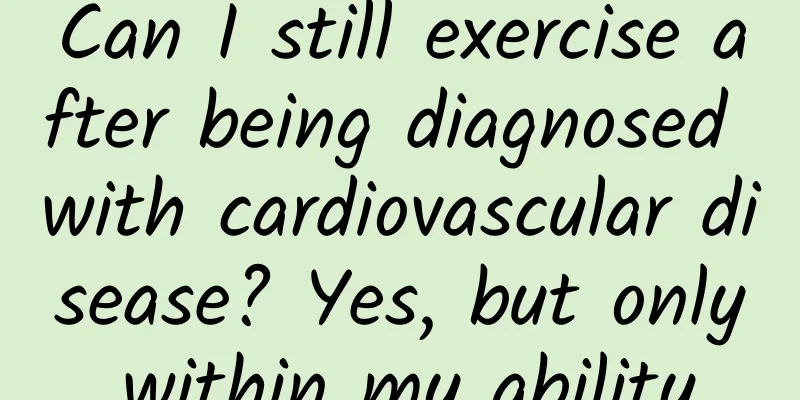Can I still exercise after being diagnosed with cardiovascular disease? Yes, but only within my ability.

|
In recent years, the incidence of cardiovascular disease in my country is not optimistic. Lack of physical activity is one of the risk factors for high incidence. In addition, maintaining a healthy lifestyle throughout life is a fundamental measure for primary prevention of cardiovascular disease. However, many patients with cardiovascular diseases are troubled by the same question - can they still exercise after being diagnosed with cardiovascular disease? The answer is you can exercise! But do it within your ability. 1. Although sudden death during exercise is scary, you should not completely resist exercise It is reported that exercise can increase the burden on the heart, reduce plasma volume and vasoconstriction, and induce risks such as angina pectoris, myocardial infarction and arrhythmia. If there is underlying coronary artery disease, it can lead to sudden cardiac death. Although sudden death during exercise is terrible, the exercise referred to here does not include all sports and levels. Excessive exercise or exercise when the disease itself is serious will increase the risk, but if you know your own tolerance level in advance and make exercise plans, you may not necessarily experience a disease attack or even sudden death. Therefore, resisting exercise is absolutely not allowed. 2. Short-term moderate exercise can bring immediate benefits and reduce all-cause mortality in the long term The "Guidelines for China's Healthy Lifestyle to Prevent Cardiovascular and Metabolic Diseases" point out that in the short term, increasing physical activity can reduce anxiety, improve sleep, and lower blood pressure; in the long term, it can reduce the risk of hypertension, diabetes, and cardiovascular disease, improve cardiopulmonary function, increase muscle strength, and reduce all-cause mortality by 20% to 30% in people of all age groups. In addition, the "Chinese Expert Consensus on Home Rehabilitation for Cardiovascular Disease Patients" also shows that cardiac rehabilitation has been proven to effectively reduce the readmission rate, mortality rate and risk of cardiovascular events in patients with cardiovascular disease, and improve health-related quality of life. 3. "6-minute walking test" to understand heart function and exercise safely 1. Purpose The "Expert Consensus on Community Cardiopulmonary Rehabilitation Treatment Technology in China" points out that the "6-minute walk test" can help patients with cardiovascular disease identify their own heart function level and determine whether they can exercise. 2. Indications Comparison of patients with chronic heart failure, coronary heart disease, and pulmonary hypertension before and after treatment; evaluation of the functional status of patients with heart failure and cardiovascular disease; prediction of the risk of cardiovascular events and death in patients with heart failure, coronary heart disease, and pulmonary hypertension. 3. Contraindications (1) Absolute contraindications: unstable angina or myocardial infarction in the past month. (2) Relative contraindications: resting heart rate >120 bpm, systolic blood pressure >180 mmHg (1 mmHg=0.133 kPa), diastolic blood pressure >100 mmHg. (3) Symptoms: The test should be stopped immediately if any of the following symptoms occur during the test, including pale complexion, profuse sweating, unsteady gait, lower limb cramps, chest tightness, and difficulty breathing. 4. Test operation The patient will move back and forth in a straight line of 30 m, and the speed can be determined by the patient. A dedicated person will report the time, with an average of 2 minutes per time. At the same time, the patient will be observed for any discomfort such as chest tightness, shortness of breath, dizziness, chest pain, etc. The test can be suspended or terminated if the patient cannot persist. Simple diagram of the “6-minute walk test” 5. Situation Analysis After the “6-min walk test”, the total exercise distance was calculated and divided into three levels according to the distance. The levels and exercise recommendations after evaluating cardiac function are shown in Table 1. 4. Reasonably grasp the scale of exercise and avoid "tragedy" 1. Heart rate calculation method Patients are advised to wear a heart rate calculator to record their heart rate. Since heart rate is positively correlated with the amount of exercise, when the heart rate reaches the maximum value allowed by the body, it is necessary to stop exercising or slow down the exercise speed, because this indicates that the amount of exercise is sufficient. It is important to understand that the heart rate at this time is called the target heart rate, and the calculation formula is (220-age) × 0.85 = target heart rate. For example, the heart rate of a 60-year-old patient after exercise should be controlled at (220-60) × 0.85 = 136 beats/minute. 2. Self-perception control method In fact, the body's self-perception is an important evidence of physiological and pathological changes in the body. If the patient feels slight sweating, fatigue, shortness of breath or chest tightness during exercise, it means that the amount of exercise is sufficient and the patient needs to gradually slow down the exercise speed, rest and relax the body in time. In addition, if the patient experiences chest tightness, obvious shortness of breath, palpitations, and profuse sweating during exercise, it indicates excessive exercise and the patient must stop exercising immediately and rest in a ventilated and cool place. In summary, although patients with cardiovascular diseases suffer from pain that is slightly different from healthy people, they still need to live an active life and keep physically active. It should be noted that if you are a patient with coronary heart disease, it is recommended that you carry nitroglycerin tablets with you. If you experience chest tightness, chest pain, or difficulty breathing, you should rest immediately and take nitroglycerin tablets sublingually. Take 1 tablet sublingually every 5 minutes. If the symptoms are not relieved after 15 minutes, myocardial infarction may have occurred. You need to call the "120" emergency number immediately and seek medical treatment in time. References: 【1】Wu Liang, Dong Jige, Guo Qi, et al. Expert consensus on community cardiopulmonary rehabilitation treatment technology in China[J]. Chinese Journal of Geriatrics, 2018: 42-52+57. 【2】Chinese Society of Geriatrics. Chinese expert consensus on the clinical application of the 6-minute walk test in elderly patients[J]. Chinese Journal of Geriatrics, 2020, 39 (11): 1241-1250. [3] Gu Dongfeng, Weng Jianping, Lu Xiangfeng, et al. Chinese Guidelines for Healthy Lifestyle to Prevent Cardiometabolic Diseases[J]. Chinese Journal of Preventive Medicine, 2020: 256-277. 【4】 Feng Xue, Chinese expert consensus writing group on home rehabilitation for patients with cardiovascular disease. Chinese expert consensus on home rehabilitation for patients with cardiovascular disease[J]. Chinese Journal of Circulation, 2022, 37(2): 14. Text and layout丨Fu Yujie |
<<: What impact do “pre-prepared meals” that almost every working person has eaten have on health?
>>: Why don’t ophthalmologists perform myopia surgery?
Recommend
Brown discharge started one week after the abortion
Medical abortion is a relatively common method of...
How to deal with chicken gizzards? How to remove the fishy smell of chicken gizzards
Friends who are familiar with and love chicken gi...
Can acupuncture treat amenorrhea?
Menstruation is a normal physiological behavior o...
What shoes should I wear when I go to Yunnan during the Spring Festival? What clothing should I wear when I go to Yunnan during the Spring Festival?
Different scenic spots in Yunnan have very differ...
White round discharge after medication abortion
White round discharge after medication abortion A...
Will drinking ice water often hurt your stomach? Will drinking hot water be fine?
Reviewer of this article: Chen Haixu, Deputy Dire...
Will drinking milk cause girls to mature early?
Milk is a beverage that many people drink regular...
How do you know what fish you are fishing in the wild? What size line and hook is suitable for fishing in the wild?
When you go fishing in an unfamiliar water area, ...
How to remove whiteheads
What should you do if large patches of whiteheads...
Canalys: Apple to lead global high-end smartphone market with 62% market share in Q2 2024
According to the latest data from market analysis...
Does anyone know about the test for gonococcal vaginitis?
Gonococcal vaginitis is a gynecological disease. ...
My butt hurts when I have my period
Women have a few days every month when they feel ...
How to treat anovulatory functional uterine bleeding? Choose according to age
Anovulatory functional uterine bleeding is more c...
See the other side of a woman from her eating habits
Although men eat in many different ways, they pal...
What to do if you have chest tightness, shortness of breath, and difficulty breathing during early pregnancy
Every woman will experience different symptoms du...









